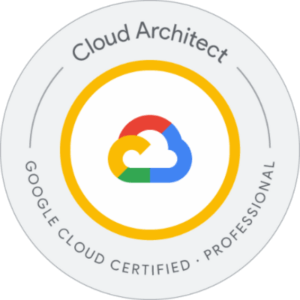Calendario
Estamos preparando nuevas convocatorias, déjanos tus datos a través del formulario y te avisaremos en cuanto estén disponibles.
Acerca del curso

Los Professional Cloud Architects permiten a las organizaciones aprovechar las tecnologías de Google Cloud. Con un conocimiento profundo de la arquitectura de la nube y Google Cloud, diseñan, desarrollan y administran soluciones sólidas, seguras, escalables, de alta disponibilidad y dinámicas para impulsar los objetivos comerciales.
El examen de certificación Professional Cloud Architect evalúa tu capacidad para:
- Diseñar y planificar la arquitectura de una solución en la nube.
- Administrar y aprovisionar la infraestructura de la solución en la nube.
- Realizar diseños para la seguridad y el cumplimiento.
- Analizar y optimizar procesos técnicos y empresariales.
- Administrar las implementaciones de la arquitectura en la nube.
- Garantizar la confiabilidad de la solución y de las operaciones.
Certificación Professional Cloud Architect
Obtener la certificación Professional Cloud Architect
- No existen requisitos previos para tomar este examen de certificación.
- Sin embargo, es recomendable tener más 3 años de experiencia en la industria y más de 1 año de experiencia en el diseño y la administración de soluciones mediante Google Cloud.
Solicita información
Descargar programa
Descargar matrícula
Si no has encontrado lo que buscabas, prueba buscar tu curso o certificación aquí
Acerca del curso
El curso Preparing for Your Professional Cloud Architect Journey te permite estructurar tu preparación para el examen de certificación Professional Cloud Architect. Aprenderás sobre los dominios de Google Cloud que se incluyen en el examen y la forma de crear un plan de estudio para saber más de ellos.
Preparación para el examen de certificación:
Professional Cloud Architect
- Describir los cinco dominios que se incluyen en el examen de certificación de Professional Cloud Architect.
- Identificar brechas en sus conocimientos y habilidades con respecto a cada dominio y crear un plan de estudio.
- Prepararte para el examen de certificación Professional Cloud Architect.
Profesionales Cloud que deseen tomar el examen de certificación Professional Cloud Architect.
Módulo 00: Introduction to the Professional Cloud Architect Certification
- Temas:
- Role of a Professional Cloud Architect and scenario introduction*
- Certification value and benefits
- Certification process
- Objetivos:
- Describe the purpose and benefits of the PCA certification.
- Explain the certification process.
Módulo 01: Designing and planning a cloud solution architecture
- Temas:
- Scenario: Defining initial technical and business design considerations for Cymbal’s migration to a cloud solution
- Objetivos:
- Identify considerations involved in designing solution infrastructure that meets business and technical requirements.
- Describe options for designing network, storage, and compute resources leveraging Google Cloud.
- Explain the elements of a migration plan.
- Recognize the potential for future solution improvements.
- Determine the skills you need to develop in order to design and plan solution architecture leveraging Google Cloud.
Módulo 02: Managing and provisioning a solution infrastructure
- Temas:
- Scenario: Provisioning and deploying the cloud solution per Cymbal’s requirements
- Objetivos:
- Identify considerations involved in configuring network topologies, individual storage systems, and compute systems.
- Determine the skills you need to develop in order to manage and provision solution infrastructure.
Módulo 03: Designing for security and compliance
- Temas:
- Scenario: Identifying the security and compliance considerations pertinent to Cymbal’s cloud solution
- Objetivos:
- Explain recommended design practices to ensure security across a cloud solution.
- Recognize aspects of designing for compliance.
- Determine the skills you need to develop in order to apply Google’s recommended approach to designing for security and compliance.
Módulo 04: Analyzing and optimizing technical and business processes
- Temas:
- Scenario: Analyze costs, KPIs, etc. and identify opportunities for optimization
- Objetivos:
- Describe the technical and business processes involved in solution production.
- Identify ways to optimize processes and develop procedures to ensure reliability of solutions in production.
- Determine the skills you need to develop to optimize technical and business processes involved in producing a cloud solution.
Módulo 05: Managing implementation/Ensuring solution operations and reliability
- Temas:
- Scenario: How the PCA helps establish best practices for Cymbal’s solution deployment and ongoing operations
- Objetivos:
- Describe best practices for development and operations teams to ensure successful solution deployment.
- Explain methods to interact with Google Cloud programmatically.
- Explain methodologies for managing configuration and code updates and tools available for monitoring and analyzing KPIs.
Módulo 06: Your Next Steps
- Temas:
- Learn how to break down a case study to pinpoint business and technical requirements, and find differentiators
- Finalizing your study plan
- Creating a weekly study sheet
- Registering for the exam
- Objetivos:
- Create a personalized study plan.
- Review next steps.
Documentación oficial para el curso Preparing for Your Professional Cloud Architect Journey.
- Formador certificado por Google Cloud.
- Más de 5 años de experiencia profesional.
- Más de 4 años de experiencia docente.
- Profesional activo en empresas del sector IT.